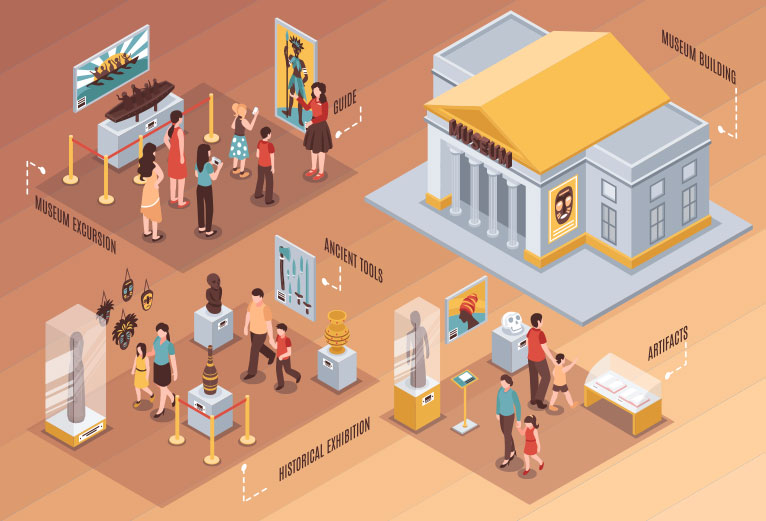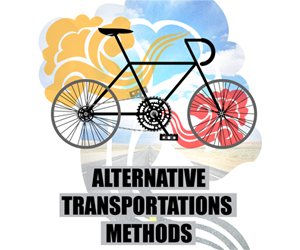
Article: Rebecca Carlsson
Picture: Education vector created by macrovector – www.freepik.com
In today’s uncertain times, museums can act as an anchor in the storm.
To those who aren’t as passionate about the power of museums as readers of this blog, it can often seem that such institutions are merely places where forgotten objects go to enjoy their final years.
But despite this, there’s a strong case to be made that the museum is more relevant today than it has ever been. From addressing key social issues to transforming how we see the future, the humble museum has the power to reflect and shape our society. Here are five reasons why we need museums now more than ever.
Learning from the past
First and foremost, museums and galleries provide an insight into the history of humankind. And while no museum can claim to provide a complete picture, the lessons we can learn from past events, wonders and tragedies are priceless.
This is especially true in times of turmoil. Today, it’s impossible to ignore the escalating tensions between nations, between political parties and between different cultural groups. Instead of finding common ground, it seems that issues of class, race, gender and environmentalism are becoming ever more polarised.
To help the public re-establish this common ground and learn to build bridges rather than breed division, many believe that museums have a role to play in giving us perspective – be it through intellectual exercises or merely holding up mistakes of the past as evidence of where such behaviour will lead us once more. This is what the museum has the power to showcase.
On 31 March 2017, the Musée de l’Homme in Paris launched a major temporary exhibition “Us and Them – From Prejudice to Racism”, organized under the patronage of UNESCO. It showcases an original immersive scenography which aims to shed new light on racist behaviour and prejudices through time. In the face of hatred and ignorance, knowledge and understanding are often the best weapons.
Bringing communities together
Museums have the power to create unity on both a social and political level, but also on a local one. Local museums are able to provide a sense of community and place by celebrating a collective heritage, offering a great way to get to know the history of a particular area.
There are endless examples of local museums in the UK. One such institution is the Hove Museum and Art Gallery, located in Hove near Brighton. Housed in an Italianate Victorian villa near the seafront, this local abode was once home to a wealthy widow before housing German prisoners of war during World War II. The home is filled with a variety of local historical treasures, including dolls, rocking horses, prints, paintings and sculptures. From prehistoric times to the pioneering 20th-century filmmaking that occurred in the area, this museum offers a comprehensive history of Hove.
As technology and digitalisation see us becoming more and more globalised, institutions such as these offer a welcome reminder of the achievements and discoveries located closer to home, bringing communities together.
Museums can also bring people together in a more literal way, through public events, workshops and lectures. The British Museum, for example, works with community organisations and charities to explore, research and respond to projects. Meanwhile, some museums like the Museum of Street Culture in Dallas, Texas create exhibitions designed to support vulnerable local people. The Museum of Street Culture recently launched a project designed to engage the public in dialogue with people experiencing homelessness, challenging stigma and increasing awareness.
Exhibits like this couldn’t come at a better time, with recent reports confirming that the levels of homelessness are actually five times higher than previously thought.
Digitalisation, innovation and interaction
Thanks to the rise in technology over the last two decades, what it means to be a museum is being questioned and challenged. Modern tech is transforming museums from spaces of looking and learning to spaces of interaction, participation and engagement.
This is evident in major institutions around the world, including the Detroit Institute of Arts. The museum’s Lumin AR Tour uses augmented reality to improve both the educational and the practical aspects of the museum experience. The tour, introduced in 2017, can be implemented on a handheld device available inside the building.
When the device is pointed at certain sculptures, artefacts or paintings, more information about them is made available. Pop-up snippets, detailed descriptions and additional photography are just a few examples of what the devices offer, increasing the average time visitors spend engaging with items inside the collection.
One of the most interesting and popular options is the ability to ‘x-ray’ an ancient mummy, allowing visitors the chance to experience the interior as well as the exterior of this fascinating find.
Similarly, the ArtLens Interactive Studio at the Cleveland Museum of Art contains a variety of screen-based activities that require physical movement and interaction from the viewer in order to operate.
Just some of the activities visitors can expect to enjoy include: virtual painting and virtual collaging (using items found throughout the gallery’s collection); researching and learning about various featured artists and mediums using portable devices; front camera self-portraiture; virtual pottery; and matching shapes to items in the gallery. Examples such as these show the changing faces of museums, as curators begin to think outside the box and develop more immersive, social and collaborative ways of learning for visitors.
Advances in technology have also made museums more accessible than ever. For those who might struggle to attend an institution in person, museums and galleries are increasingly sharing their collections online. Virtual reality, digital guides, downloads, apps and digital trails are all becoming increasingly available to anyone and everyone.
We need museums because their future is so full of possibility and opportunity – and more people than ever can access them.
Educating future generations
Speaking of the future, museums and other cultural institutions will always have a role to play in the education of future generations. From creating exhibitions targeted towards children to teaching children in a quasi-classroom environment, institutions around the world are doing their bit to pass down knowledge.
Back in 1990, Semper described a museum as “an educational country fair” – and this is more true today than ever. In the United States alone, around 80% of museums provide educational programmes for children, and spend more than $2 billion per year on educational activities, according to the American Alliance of Museums.
What’s more, traditional museum spaces are also offering interactive exhibitions and opportunities for children. The Tate in London offers a dedicated website for children about art – Tate Kids – which allows children to play games and quizzes, watch videos about art and be inspired to make their own creations at home. They can also share their creation with other children around the world via the site’s online gallery.
Museums are just as important to the future as the future is to museums. Not only can our museums bring history to life, but they can also shine a light on both our present and our future – a light which can be hard to find elsewhere.
Adapted from https://www.museumnext.com/article/why-we-need-museums-now-more-than-ever/


















